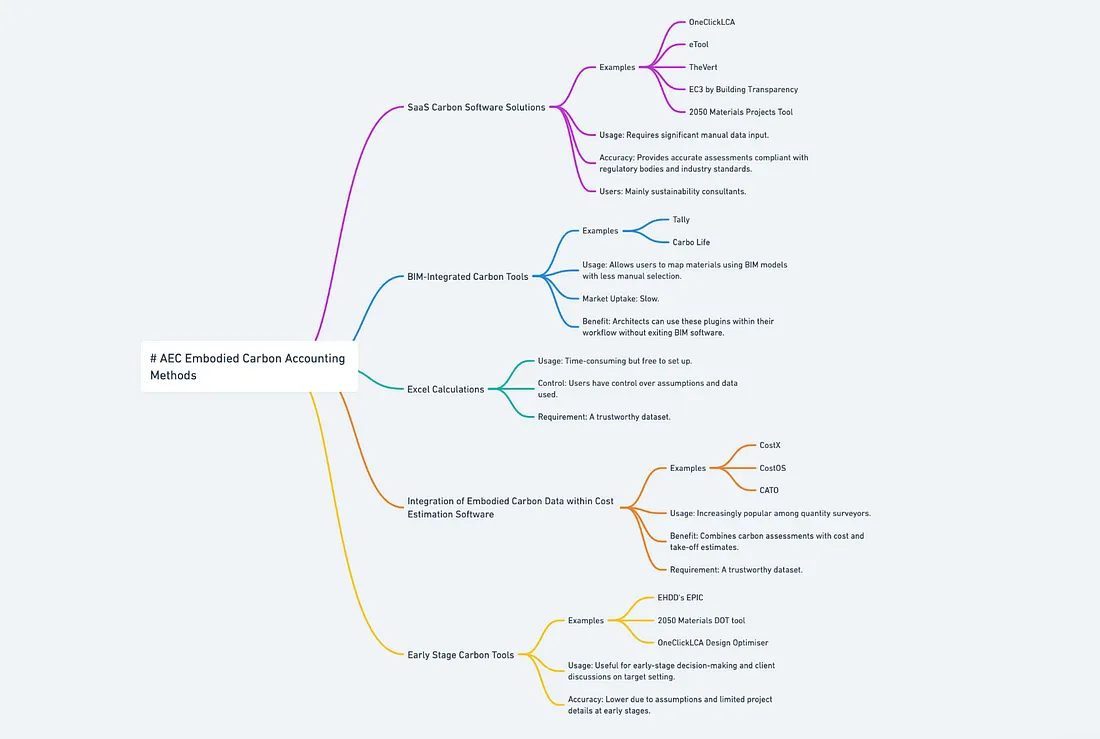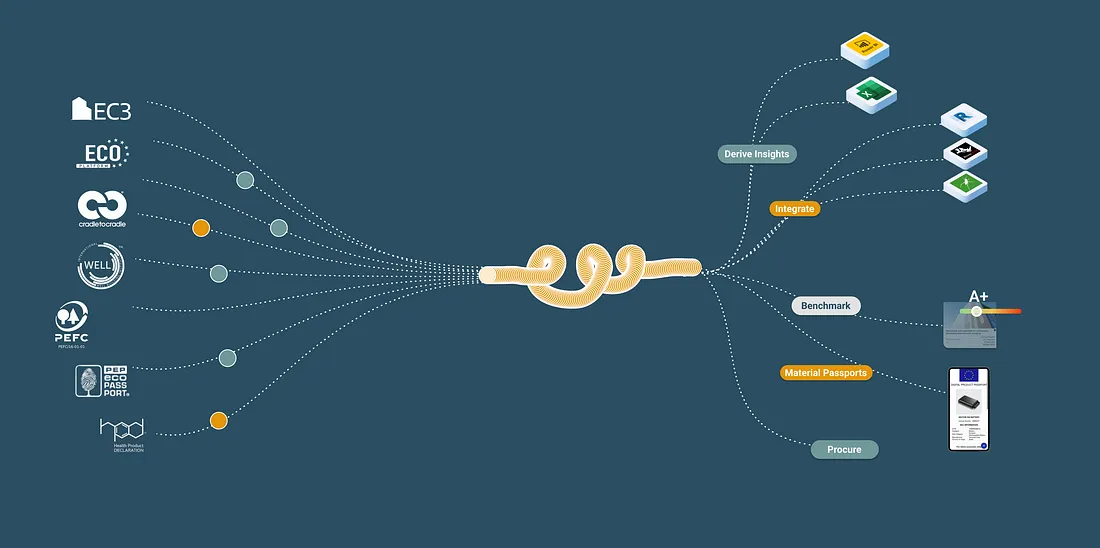Understanding How the AEC Industry Calculates Embodied Carbon in 2024

The Architecture, Engineering, and Construction (AEC) industry plays a critical role in addressing climate change by reducing the carbon footprint of buildings. A significant part of this effort involves calculating and managing embodied carbon — the carbon dioxide emissions associated with building materials throughout their lifecycle. Here’s an overview of the primary methods and tools used in the AEC industry to calculate embodied carbon.
1. SaaS Carbon Software Solutions
SaaS (Software as a Service) carbon software solutions are widely used in the AEC industry for their accuracy and compliance with regulatory standards. Examples of these tools include OneClickLCA, eTool, TheVert, EC3 by Building Transparency, and 2050 Materials Projects Tool. These solutions require significant manual data input, which can be time-consuming but ensures precise assessments. They are primarily used by sustainability consultants who specialize in carbon analysis.
2. BIM-Integrated Carbon Tools
Building Information Modeling (BIM) integrated carbon tools offer the advantage of incorporating carbon calculations directly within the BIM workflow. Tools like Tally and Carbo Life enable users to map materials in their BIM models with minimal manual selection. Although market uptake has been slow, these tools allow architects to seamlessly integrate carbon assessments into their design process, enhancing efficiency and accuracy.
3. Excel Calculations
Many firms in the AEC industry still rely on Excel for calculating embodied carbon. This method is time-consuming but offers complete control over the assumptions and data used. While it doesn’t require expensive software, it demands a trustworthy dataset to ensure reliable results. Excel calculations are a flexible option for those who prefer a customized approach to carbon assessment.
4. Integration of Embodied Carbon Data within Cost Estimation Software
Integrating embodied carbon data within cost estimation software is an emerging trend, particularly among quantity surveyors. Tools like CostX, CostOS, and CATO combine carbon assessments with cost and take-off estimates. This integration allows quantity surveyors to provide comprehensive evaluations that include both financial and environmental impacts, making it easier to balance cost and sustainability goals.
5. Early Stage Carbon Tools
Early-stage carbon tools are designed to support decision-making at the initial stages of a project. Examples include EHDD’s EPIC, 2050 Materials DOT tool, and OneClickLCA Design Optimiser. These tools are valuable for setting targets and discussing sustainability ambitions with clients, although they tend to be less accurate due to the assumptions made with limited project details.
6. Custom Carbon Calculation Tools for Specialized Needs
In some cases, firms develop custom carbon calculation tools to meet the unique needs of specific projects or materials. For example, a multidisciplinary team might use a combination of Excel, Grasshopper (Rhino), and Revit plugins to analyze embodied carbon across different aspects of a building, such as facades, structures, and glazing systems. These custom tools allow for in-depth analysis and provide flexibility in choosing relevant Environmental Product Declarations (EPDs) that meet specific standards, such as EN15804+A2.
A major challenge faced by these teams is the need to filter and customize EPDs to ensure they are relevant and accurate for their projects. This process often involves significant manual oversight to verify that the data aligns with the required standards, making the carbon assessments both detailed and project-specific.
The common denominator
A key component of all the methods and tools used to calculate embodied carbon in the AEC industry is the underlying data on materials, assemblies, and products. Accurate and comprehensive data is essential for making precise carbon assessments, regardless of the tool or method employed.

Importance of Material, Assembly, and Product Data
Material, assembly, and product data include Environmental Product Declarations (EPDs), Health Product Declarations (HPDs), and other certifications like Cradle to Cradle (C2C). These data points provide detailed information about the environmental impact of materials and products throughout their lifecycle, from extraction and manufacturing to use and disposal.
The duplication of data collection and maintenance is a significant issue that hampers the climate transition. When different tools and firms collect and manage their own data independently, it leads to inefficiencies, inconsistencies, and increased costs. Moreover, the fragmented approach to data management can result in outdated or inaccurate information being used, ultimately affecting the reliability of carbon assessments.
The Role of Data Aggregators
To address these challenges, the use of data aggregators is essential. Data aggregators compile and maintain comprehensive databases of material, assembly, and product information, ensuring that all stakeholders have access to consistent, reliable, and up-to-date data.
Key Data Aggregators:
- Eco Platform: Specializes in EPDs for Europe, providing a standardized and centralized source of environmental data for products used across the continent.
- EC3: Focuses on EPDs in the US, offering a robust database that supports accurate carbon assessments for building projects.
- 2050 Materials: Provides a comprehensive global database that includes EPDs, HPDs, C2C certificates, and the largest collection of generic materials and assemblies data. This platform ensures that users have access to the most extensive and reliable product information available worldwide.
To drive the climate transition effectively, it is crucial for the AEC industry to adopt and utilize these data aggregators. By leveraging centralized databases, professionals can reduce redundancy, improve accuracy, and streamline the process of carbon assessment. This approach not only enhances efficiency but also ensures that the industry is making informed decisions based on the best available data.
Adopting data aggregators like Eco Platform, EC3, and 2050 Materials is a critical step towards achieving a low-carbon future. By using these comprehensive sources of information, the AEC industry can better manage embodied carbon, contribute to sustainability goals, and play a pivotal role in combating climate change.
Conclusion
The journey towards reducing embodied carbon in the AEC industry is complex, requiring the integration of accurate data and efficient tools. Material, assembly, and product data are the backbone of all carbon assessment methods. Addressing the duplication of data collection and embracing data aggregators can significantly enhance the industry’s ability to make sustainable choices. As we move forward, adopting these solutions will be key to achieving our environmental objectives and ensuring a sustainable future for all.
Related articles

Climate-Resilient Materials for the Built Environment: A Data-Centred Prime
As climate volatility intensifies, resilience metrics are fast becoming as critical as carbon data in material selection. This article outlines why adaptation is now a design imperative, how materials can be evaluated through a systems lens, and what KPIs project teams should demand. From self-healing concrete to fire-rated façades, we present a structured taxonomy of resilient materials, explain how to embed this intelligence into digital design workflows, and propose next steps for specification, benchmarking, and procurement.
Read more
The Most Interesting Low Carbon Products in Office Design
In this article and collection, we highlight 11 outstanding products that contribute to a lower carbon footprint in office design.
Read more
Top Low Carbon Building Boards: Performance, Benefits, and Use Cases
The building boards highlighted in this article and collection showcase low-carbon innovation in modern construction.
Read more